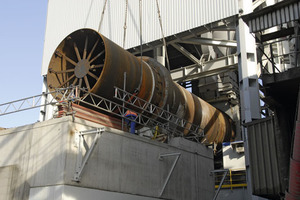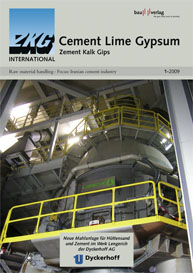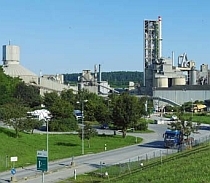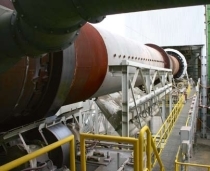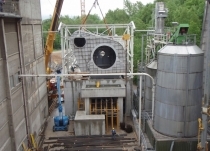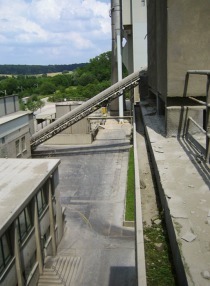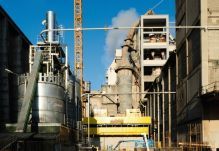Modernization of the Lafarge plant in Wössingen: Next step completed
ZKG-Interview Berthold PerschallLafarge Zement is investing about 50 million Euro in the modernization of the Wössingen cement works. The production process is being converted from the Lepol process to the energy-saving dry process with preheater and precalciner with very little interruption to the operation. At the same time the plant is being changed from 2-kiln operation to a single rotary kiln. The top level of the preheater tower has already been completed. The aim is to fire up the renovated kiln plant again in the first quarter of 2009. ZKG INTERNATIONAL found out about the state of the conversion work (as at 21.11.2008) from Berthold Perschall, Investment Manager Plant Project, at Lafarge Zement.
ZKG: How far have you now progressed with the modernization work at the Wössingen works?
Berthold Perschall: We have progressed a good deal further in the last few months. The preheater tower has reached its final height, i.e. the structural steelwork, including installation of the process equipment, is complete. The internal installation is now taking place, i.e. installation of the refractory materials. A start has also been made on the electrical installations.
At the moment the work is concentrating on the conversion of the filter systems, where we are replacing the kiln filter and installing a bypass. In future the exhaust gases will be cleaned with bag filters instead of electrostatic precipitators.
The gas conditioning tower is also under construction. At the moment it has reached a height of 50 m. Unfortunately, today’s storm is preventing us from using the cranes and positioning the next preassembled component.
ZKG: What experience have you gained during the erection of the preheater tower? With hindsight, what is it necessary to look out for?
Berthold Perschall: The construction of the preheater tower was a particular challenge. The project was not being carried out on a turn-key basis by a general contractor, so we ourselves are having to coordinate a large number of suppliers. This means not just agreeing the actual work but also a very much greater organizational effort. For example, because of the constricted construction site it was necessary to allocate storage and assembly areas in advance for a specific time window for each section of work. We are also making sure that work at the same position but on different levels is always coordinated. Otherwise this would lead to an unacceptable safety risk.
Health and safety is an important topic everywhere at Lafarge. Every outside company and every employee must be instructed in our regulations, and work so that neither they nor others are put at risk. If the rules are not obeyed then individual members, and also entire companies, are shown first a yellow card and then, if the offence is repeated, a red card. So far we have made two dozen dismissals. This consistent approach has been successful. With about 220 000 working hours (as at 20.11.2008) by more than 330 employees there have fortunately not yet been any industrial accidents entailing loss of working hours.
We have established important organizational requirements for regulated procedures. In general, all the work on the site has to be coordinated by our site and construction engineers. No activity can take place until it has been cleared, which means that they have released a written working permit. Our site engineers, together with our safety experts, carry out a continuous and comprehensive survey of all the work to check whether any risks could arise. They only give clearance for work when any risk to personnel has been eliminated. The specialist safety personnel on the building site know the intended work plan and watch out to ensure that the activities are completed at the intended time in the specified places. For the typical high-risk activities there are also welding permits, a permit system for working in confined spaces and lifting permits for heavy lifts.
The entire construction site is surrounded by existing buildings (Figs. 2–5) so it is very constricted. In carrying out the construction work we are therefore heavily dependent on cranes and the appropriate weather conditions. The mild autumn so far has therefore been an advantage.
ZKG: What preliminary work was necessary to prepare for the kiln switch-over?
Berthold Perschall: We needed new first and last kiln segments for the kiln. We had these segments, as well as the kiln tyres, made in advance. As far as possible all the preassembly work was carried out before the kiln shutdown so that complete assemblies could be lifted into place when positioning the kiln (Figs. 6 and 7).
ZKG: How was the kiln conversion carried out?
Berthold Perschall: We finished the preassembly work on the kiln segments in mid October. The components are being completed and the kiln is being positioned during the shutdown, i.e. the measuring, fine alignment and welding of the segments, and placement of the refractory lining and the drive train are being completed. At the same time we are also dismantling old parts of the plant that are no longer needed.
ZKG: What comes next?
Berthold Perschall: After the kiln has been positioned the rest of the work leading up to recommissioning will follow – construction of a new cooler exhaust air filter, completion of all material and flue gas ducts, completion of the refractory work in all the components operating at high temperatures and installation of the instrumentation and control technology.
The mechanical assembly of our new clinker cooler has already been completed. Here again the refractory material is still to be installed before the complete plant can be commissioned. We are also building new silos for handling the bypass dust, additions and feed materials for the cement mills.
Last but not least: Our sales department is also getting more space with the new administration building and will move in there in the coming year together with its concrete laboratory.
ZKG: Many thanks for the interview.

